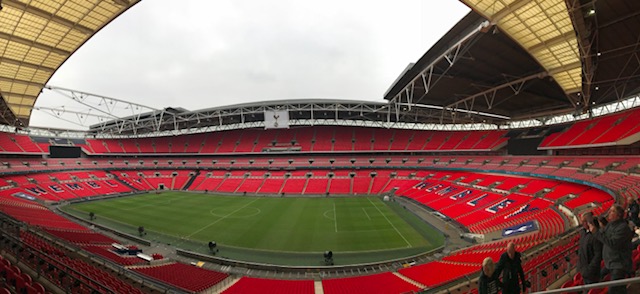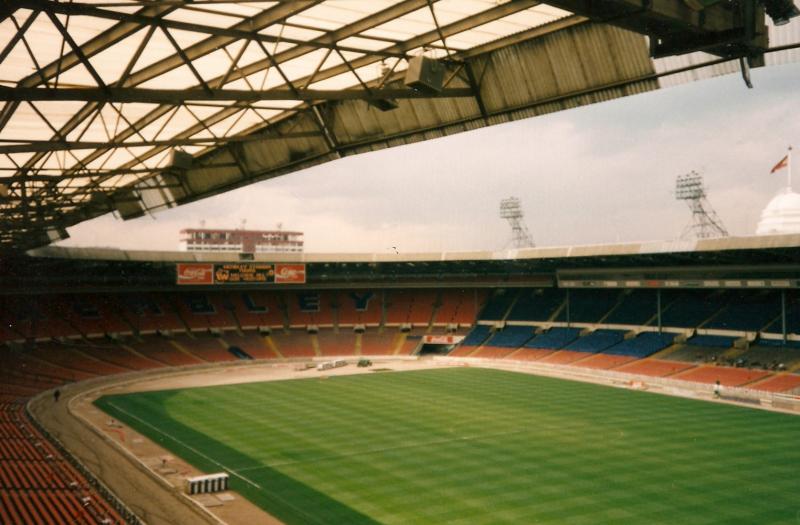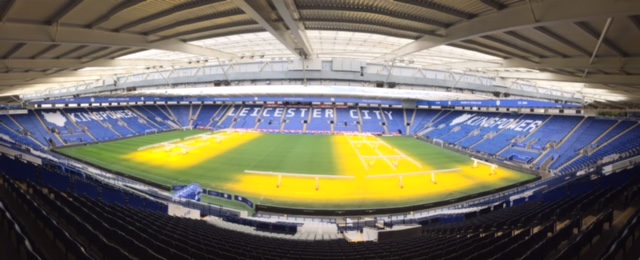
It has been a while since Mateo and I went to visit a stadium. Today was the perfect day. Sunny and windy. Too cold to go outside but too nice to stay inside. So nothing better than go and visit our 12th Premier League ground and 15th ground all together by visiting one of the best stadium in the League, Craven cottage home of the Fulham Football Club. I have fond memories of this stadium as I won the FxPro Cup back in 2012 scoring a goal from an assist of World Cup winner Robert Pires. I lived to tell the tale, priceless! As much as I could sense some pride in my son’s voice, after 5 min of recounting the tale…he was, how do you say, bored!
Craven cottage
Craven Cottage is a football stadium located in Fulham, London. It has been the home ground of Fulham F.C. since 1896. The ground’s current capacity is 25,700, all-seated, though the record attendance is 49,335, for a game against Millwall, 8 October 1938. Located next to Bishop’s Park on the banks of the River Thames, ‘Craven Cottage’ was originally a royal hunting lodge and has history dating back over 300 years. As we parked Finlay St, we could see the well recognised cottage, with its black paint and its words ‘The Fulham Football Club. A beauty!
The original ‘Cottage’ was built in 1780, by William Craven, the sixth Baron Craven and was located on the centre circle of the pitch. At the time, the surrounding areas were woods which made up part of Anne Boleyn’s hunting grounds.
The Cottage was lived in by Edward Bulwer-Lytton and other somewhat notable (and moneyed) persons until it was destroyed by fire in May 1888. Many rumours persist among Fulham fans of past tenants of Craven Cottage. Sir Arthur Conan Doyle, Jeremy Bentham, Florence Nightingale and even Queen Victoria are reputed to have stayed there, although there is no real evidence for this. Following the fire, the site was abandoned. Fulham had had 8 previous grounds before settling in at Craven Cottage for good. Therefore, The Cottagers have had 12 grounds overall (including a temporary stay at Loftus Road), meaning that only their former ‘landlords’ and rivals QPR have had more home grounds (14) in British football. Of particular note, was Ranelagh House, Fulham’s palatial home from 1886–1888.
When representatives of Fulham first came across the land, in 1894, it was so overgrown that it took two years to be made suitable for football to be played on it. A deal was struck for the owners of the ground to carry out the work, in return for which they would receive a proportion of the gate receipts.
The first football match at which there were any gate receipts was when Fulham played against Minerva in the Middlesex Senior Cup, on 10 October 1896. The ground’s first stand was built shortly after. Described as looking like an “orange box”, it consisted of four wooden structures each holding some 250 seats, and later was affectionately nicknamed the “rabbit hutch”.
In 1904 London County Council became concerned with the level of safety at the ground, and tried to get it closed. A court case followed in January 1905, as a result of which Archibald Leitch, a Scottish architect who had risen to prominence after his building of the Ibrox Stadium, a few years earlier, was hired to work on the stadium. In a scheme costing £15,000 (a record for the time), he built a pavilion (the present-day ‘Cottage’ itself) and the Stevenage Road Stand, in his characteristic red brick style.
The stand on Stevenage Road celebrated its centenary in the 2005–2006 season and, following the death of Fulham FC’s favourite son, former England captain Johnny Haynes, in a car accident in October 2005 the Stevenage Road Stand was renamed the Johnny Haynes Stand after the club sought the opinions of Fulham supporters.
Both the Johnny Haynes Stand and Cottage remain among the finest examples of Archibald Leitch football architecture to remain in existence and both have been designated as Grade II listed buildings.
An England v Wales match was played at the ground in 1907, followed by a rugby league international between England and Australia in 1911.
One of the club’s directors Henry Norris, and his friend William Hall, took over Arsenal in the early 1910s, the plan being to merge Fulham with Arsenal (I am glad it did not happen, to form a “London superclub” at Craven Cottage. This move was largely motivated by Fulham’s failure thus far to gain promotion to the top division of English football. There were also plans for Henry Norris to build a larger stadium on the other side of Stevenage Road but there was little need after the merger idea failed. During this era, the Cottage was used for choir singing and marching bands along with other performances, and Mass.
In 1933 there were plans to demolish the ground and start again from scratch with a new 80,000 capacity stadium. These plans never materialised mainly due to the Great Depression.
On 8 October 1938, 49,335 spectators watched Fulham play Millwall. The reason for this exceptionally large crowd was that the game at Stamford Bridge had suddenly been cancelled and so a lot of people made their way west to the Cottage that afternoon instead. It was the largest attendance ever at Craven Cottage and the record remains today, unlikely to be bettered as it is now an all-seater stadium with currently no room for more than 25,700. During the 1930-60’s era, Fulham often averaged over 25,000. However, the official attendances can be considered somewhat dubious in this era as many fans would get in by climbing over the fence from Bishops Park into the Putney End. As at many other grounds, fans would sometimes pay at the turnstiles but not be counted. This boot money would be given to the players (stuffed in their boots) and would not be counted in the gate money. The ground hosted several football games for the 1948 Summer Olympics, and is one of the last extant that did.
Architect
Born in Glasgow, Leitch’s early work was on designing tea factories in Deltota in the former Kandyan Kingdom of Ceylon, as well as factories in his home city and in Lanarkshire, the sole surviving example of which being the category A listed Sentinel Works at Jessie Street, Polmadie, just south of Glasgow city centre. In 1896 he became a member of the Institution of Engineers and Shipbuilders in Scotland, and later of the Institution of Mechanical Engineers.[3] He moved into stadium design when he was commissioned to build Ibrox Park, the new home ground of his boyhood heroes Rangers, in 1899.
At the centre of football’s architecture, he built or was involved with the following grounds:
- Anfield, Liverpool
- Arsenal Stadium, Highbury, London
- Ayresome Park, Middlesbrough
- Bramall Lane, Sheffield
- Cardiff Arms Park, Cardiff
- Craven Cottage, Fulham, London
- Dalymount Park, Dublin
- Deepdale, Preston
- The Old Den, New Cross, London
- Dens Park, Dundee
- The Dell, Southampton
- Ewood Park, Blackburn
- The Double Decker stand (The Kop), Filbert Street, Leicester
- Fratton Park, Portsmouth
- Goodison Park, Liverpool
- Hampden Park, Glasgow
- Home Park, Plymouth
- Hyde Road Football Stadium, Manchester (General ground improvements 1911-1914 and was planning a complete rebuild of the ground to accommodate 100,000 but war broke out, bringing a halt to those plans)
- Ibrox Park, Glasgow
- Hillsborough Stadium, Sheffield
- Lansdowne Road, Dublin
- Leeds Road, Huddersfield
- Molineux, Wolverhampton
- Old Trafford, Trafford, Greater Manchester
- Park Avenue, Bradford
- Roker Park, Sunderland
- Rugby Park, Kilmarnock
- Saltergate, Chesterfield
- Selhurst Park, South Norwood, London
- Somerset Park, Ayr
- Stamford Bridge, Walham Green, London fulham
- Starks Park, Kirkcaldy
- Twickenham Stadium, Twickenham, London
- Tynecastle Park, Edinburgh
- Valley Parade, Bradford (Midland Road stand and other extensions)
- Villa Park, Birmingham
- West Ham Stadium, Custom House, London
- White Hart Lane, Tottenham, London
- Windsor Park, Belfast
Stadium Tour
We bought our tickets online. £15 per adult and free under 5. Once you have purchased be 15min before your tour is due in front of the Johnny Haynes statue, Stevenage Road.
Our guide today was Ian, very polite and welcoming. He started by telling us all about Johnny Hayes, and his £20 a week wage, and then about the Cottage. The Hayes stand is protected by English Heritage and cannot be touched apart for security features upgrades. It is a beautiful architecture, a bit like the Aston Villa stand. It is made of distinctive red bricks and harbour some of the smallest turnstile entrances I have ever seen. I tell you now, if you have eaten few pies do not attempt! The wall of the stand outside harbours the creation date of Fulham, which is 1880. But in reality, it was created in 1879. The builder got it wrong and they didn’t have the heart to tell him once he had finished his piece of art.
We then make our way through a quick security check and Ian tells us that actually it is the only stand in the league whereby once you have scanned your ticket it still requires a steward to press a button with his foot to let the fan go through the turnstile! Incredible, in this modern area, whereby everything is activated by technology, this is quite amazing. The reason is simple, it is protected by English Heritage laws. I love it!
Fulham are building a new stadium that will see the corners being filled and advancing 10m into the Thames. Pedestrians will be able to stay on the Thames path, rather than go around as it is nowadays.
As Ian is talking, I ask about how much the pitch cost. Most Premier League pitches are in and around £2m to £3m. Well this is thwarted by the £5m it cost Fulham on a yearly basis. One hell of a dent into your budget! He explains that the grass is a mix of natural and synthetic. Specialist like Grassmaster make it a business. It takes two weeks for a machine to blend the grass! they also use 4 types of seeds as there is always 1 type of seed that the pigeons do not like. Crazy but true. Who says football is not a science.
As we visit the executive suite, which by the way needs redone and chairs changed (some of the leather is gone!), we then make our way to the balcony, which is in the cottage. By the way, the cottage was designed by mistake when the architect realised that he had not created dressing rooms. I think somewhere deep he meant it! Inside the cottage is a room for players’ families. They have a bar, toys for kids and all necessary amenities. It is small and therefore cosy. We then make our way onto the balcony, great view but…wooden seats! Wow. This is true for most of the Haynes stand. The story, not yet verified, is that the seats were bought from a theatre in Yorkshire. Every penny counts. Not the most comfortable but they have lived through centuries. I personally do not mind.
Onto the final stage of the tour, which by the way is now well into the hour and a half. The dressing rooms. First the away dressing room, which is rather large and what you would expect from a dressing room. But the home one is tiny. Really cosy. I had to count the amount of seats to make sure everyone could be accommodated. I found on the wall an intriguing poster, which was the Pitch Protection Act from the Premier League. Have a read, really interesting and apologies if the photo is a bit blurry (someone was pulling my arm!!)

There is an adjacent room, which is where the players have lunch together, 4 massage tables and an indoor bicycle. This is also the place where they do drug tests. Ian tells us that Sessegnon once had to wait until late evening before doing is urine sample, which by the time only the groundsman was left. Kitman and all staff gone. He took his kit to his mum who washed it and presented back to the kitman the next day in a perfect state. Apparently not a common thing done nowadays. in contrast with the old days, where young players used to wash the boots of senior players. We then went into the refs dressing room and got to trigger the buzz informing both teams to get out onto the pitch. Finally, we went to the PR room and got to do the interviews today. Mateo had much to say!
As any good stadium tour we ended our journey into the megastore, time for us to say thank you to Ian and for me to recount one last time how I came to score on this famous and wonderful ground.
http://www.fulhamfc.com/meetings-and-events/stadium-tours
Cost: £15 adult, £12 juniors and free under 5
Stadium architecture: 10/10
Stadium history: 7/10
Stadium tour: 8/10
Overall mark: 8/10
Interesting fact: when Khan bought the football club from Al Fayed, he removed that hidious Michael Jackson’s statue. He asked Al Fayed if he wanted it and he said no. But he did state, if you remove it, it will bring bad luck and send Fulham to the championship. Surely enough, the statue was removed and …Fulham went down!
Benoit Mercier









